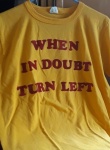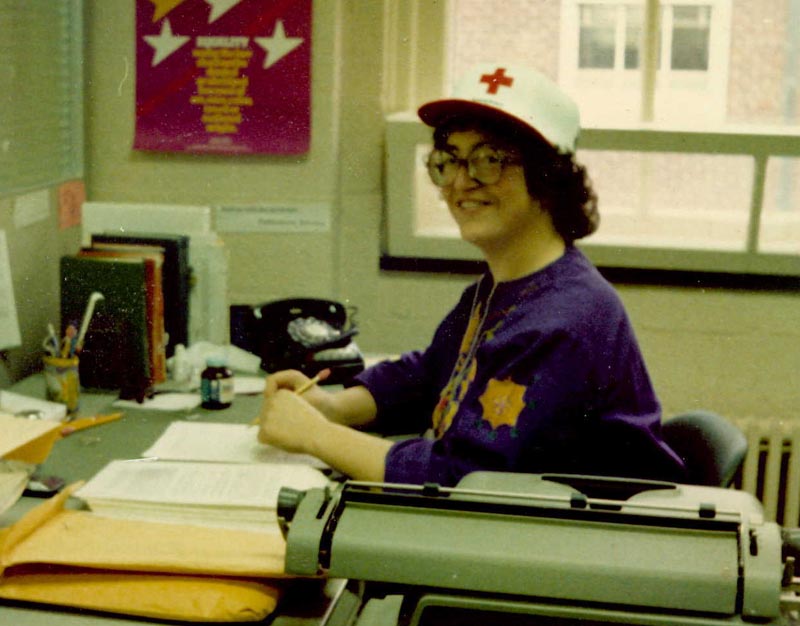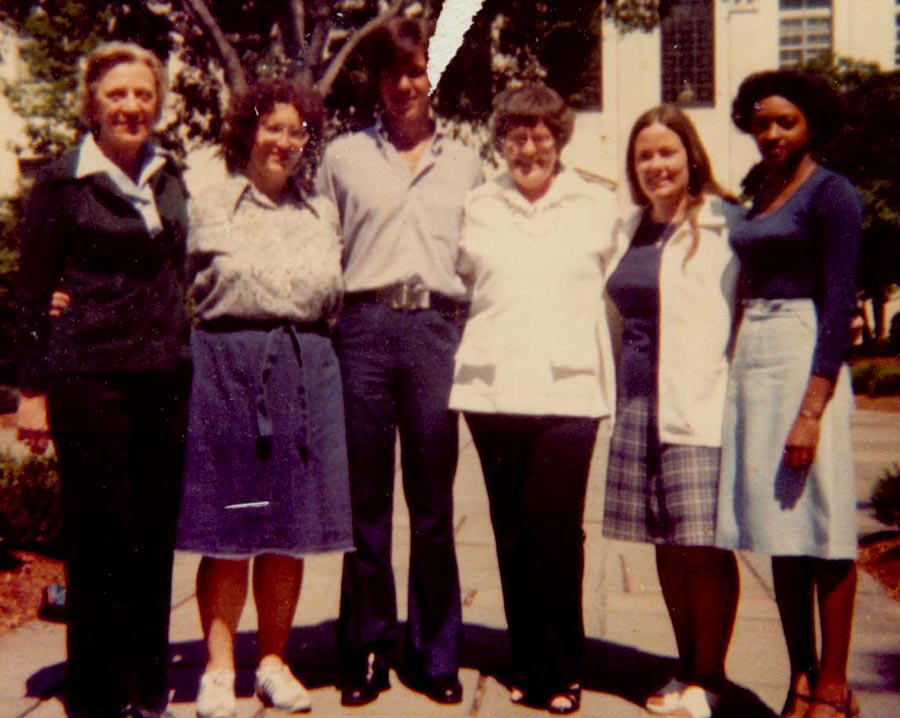My first full-time paid job with job title “editor” gave me a career path when I didn’t know what a career path was. I didn’t even know what an editor was. I did understand what editing was, but wasn’t it just something that writers did?
I landed in this job through a series of coincidences any one of which could have turned me in a different direction. The first was getting hired as a clerical at Red Cross national headquarters. The next was transferring into the Office of Personnel Training and Development.
I liked my colleagues in the training office, especially Betty O. and Thom, the work was interesting, but I had a strong hunch that I wouldn’t be there long. When an opening for Publications Editor appeared on the internal help-wanted list, Betty O. and, especially, Thom pushed me to apply. I did.

I aced the editing test and must have done OK in the interview, because I was offered the job. After I started, I was told by one of my new colleagues, somewhat breathlessly, that on the test I had “scored higher than a Harvard Ph.D.” Even then I knew better than to be impressed by this.
I also learned that my soon-to-be supervisors had had to go to bat for me, because the Personnel Office tried to block my promotion. I was jumping from grade 23, in the clerical ranks, to grade 28, which was considered professional: this apparently was not done. The staffing specialist in charge of professional positions demanded that I produce evidence that I had graduated from college, a requirement for grades 28 and up. I took the wind out of her sails by showing up with my diploma, which certified me a 1974 graduate in history of the University of Pennsylvania, magna cum laude.

Thom made me that orange EDITOR shirt to celebrate. He also gave me WHEN IN DOUBT TURN LEFT, which was something I said fairly often, having figured it out while hiking and hitchhiking around Great Britain and Ireland in 1975. Neither one of them has gone out of date.
The publications office, known as Publication Services, was located on the fringe of Alexandria’s Old Town, in the Red Cross’s Eastern Field Office building (which I was told had once been a brewery). In its big, high-ceilinged room, the editors had cubicles down one side and production was on the other. The director and deputy director had offices in opposite corners at one end; the art department was down the hall. I soon presstyped myself a sign for my cubicle: “Cubicle 4, OOPS: Making the Semiliterate Printable.” OOPS stood for Office of Publications Services, which wasn’t quite the official name but close enough.
The best thing about Cubicle 4 was that next door was Sylvia Abrams, editor extraordinaire. She had been an editor in New York before her second marriage brought her to D.C. I am not kidding when I say that working under her wing for two years made it possible for me to earn a living as a reasonably competent editor for 40 years and counting. She introduced me to the University of Chicago Press’s A Manual of Style, 12th edition, which shortly changed its name to what everyone called it anyway: the Chicago Manual of Style. It’s currently up to edition 17, and I’m still using it regularly and still complaining about the lousy index, though I do admit that it’s improved over the years.

Sylvia answered my questions. She looked my work over and made comments whenever I asked her to. She showed me interesting challenges from her own work. She passed on editorial nuggets from her extensive experience. I’m probably part of the last generation to learn editing the old way, by apprenticeship to a master, and till the day I die I’ll be grateful I had the opportunity to work alongside her.
The job was ideal for a fledgling editor in other ways as well. The stuff we edited ranged from bureaucratic forms that required minimal changes to brochures, training manuals, and textbooks for Red Cross courses. In general the authors were not professional writers. In some cases the task of producing a document fell to whoever hadn’t said “Not me!” fast enough. Each edited ms. had to be cleared face-to-face with the writer. This required tact as well as expertise; often it was the less experienced and least willing writers who were the most touchy.
In my more than two decades of freelancing mostly for publishers, I usually don’t have any direct contact with the authors whose manuscripts I work on. Nevertheless, I mentally explain my more substantive edits to those invisible authors and write my queries as if I were speaking them aloud. It’s a great habit for an editor to get into, and for me it started in the Red Cross publications office.
I must confess, though, that like many novice editors, I did suffer from “piss on fire hydrant syndrome”: making changes that didn’t need to be made mainly to prove that I was well versed in editorial esoterica. For several years after I learned the which/that distinction (that for restrictive clauses, which for nonrestrictive), I was a menace with a red pencil.
I was the office wiseass. On one wall of my cubicle I taped the before and after versions of especially challenging sentences. Some repeat writers scanned the wall to see if any of their prose had earned a place on it. Editors and artists all submitted biweekly reports of all the jobs we were in charge of. All that was required was each job’s title and status, and that was all that most of my colleagues delivered. Not me, however. I’ve still got copies of several of mine, and it’s a wonder I got away with that much wiseassery.
But I did. When I left the Publications Office after two years, my performance review was stellar. Wrote my immediate supervisor:
“Projects edited by Susanna Sturgis were frequently highly praised by both the sponsoring offices and Publications Services. She was successfully responsible for projects that involved extensive rewriting to minimize jargon and vagueness. Her sensitivity to logic was valuable.
“Miss Sturgis worked efficiently under time pressure and demonstrated ability to organize and carry out a variety of projects simultaneously.”
Was I really that good? I hope so.
Though I loved the work and my colleagues, I liked less and less what I saw of the way big bureaucracies — or at least this big bureaucracy — operated. The epitome of this was Frank, the deputy director of Publications. Frank was built like the Little King in the old comic strip, only taller. To call him incompetent is too polite. He’d been at National Headquarters for over 15 years, and it seems his spots hadn’t changed in the least. Rather than fire him or get him to shape up, one office would pass him on to the next via lateral transfer or promotion, always with a glowing performance review. At some point the glowing reviews made it impossible to fire him; he was gay, D.C. had a Human Rights Act, and he would have had a strong case for a discrimination suit if anyone had told the truth: he could have pointed to those reviews as evidence that the firing was not for cause.
None of us were sure what he did all day. He would occasionally call one of the editors from his corner office and ask us to look up a word: we had Webster’s Second International (Sylvia’s prized copy) on a lectern at one end of our little corridor and Webster’s Third at the other. Frank, like all the rest of us, had a standard-size dictionary in his office. He quickly learned not to call me, because I’d say I was busy and suggest he look it up himself.
Monday mornings he’d often come round to each cubicle and tell each of us in turn what he eaten at his several-course Sunday dinner. Of course the less reverent among us made fun of him behind his back, but after a while I got fed up. I went round to all my colleagues, asked what they’d had for supper the day before, typed it up, put it in a frame, and left it on Frank’s desk. Thus ended the Sunday-dinner recitations.
After trying unsuccessfully to get higher-ups to take the Frank problem seriously, I gave notice in the spring of 1981. I left the Red Cross a month or so before my 30th birthday, thinking I was going to take a little time off to write before finding another job. That’s not the way it worked out.

If you want to leave a comment and don’t see a Leave a Reply box, click the title of the post and then scroll to the bottom.



